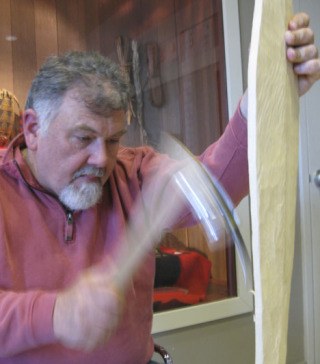Hand the man a customized tool and a splendid piece of cedar and he finds his comfort zone.
He also steps back in time.
For Auburn’s Greg Watson, there is nothing like carving something wonderful from wood, shaped by the strength and dexterity of one’s own hands, molded by an age-old instrument.
Such an exercise is rooted in the very soul of this devoted historian, scholar, teacher and artist. Making practical things from the good Earth is gratifying, humbling and captivating.
“It’s addicting,” Watson said of his carefully-sculpted woodwork, which offers lessons he shares with his many students and the curious public. “For me, this is something that can be enjoyable, that can help you get in touch with something that’s bigger than yourself.
“It is a connection with the past … ,” he added. “It is something old but very much alive.”
Watson – with his skills and knowledge of woodwork, then and now – brought the past to life as a guest curator at the White River Valley Museum last weekend.
Watson’s discussions and demonstrations are part of the museum’s multi-cultural, program-filled exhibit, “Woodworks, Things of Use and Beauty”, which runs until July 26.
The collection honors the skills of carving, joinery and cabinetry with a focus on three cultural traditions: Coast Salish Native, European-American and Japanese-American.
Watson has a deep understanding and appreciation of other cultures and wood-based artifacts. Some of them, including a cedar-hull canoe carved in the Salish tradition, are on display at the museum.
Such beautiful works give him pause.
“I think about the depth of time, from all around the world, the people who have been making things from these materials and the intermeshing (of nature and cultures),” Watson said.
From the earliest times, men and women have shaped wood into the necessities of life and the ornaments of culture. It required skill and reliable tools that were tried, tested and improved over time – beginning with sharpened stone and evolving into tempered steel and exacting measurements.
To demonstrate this, Watson adroitly applied the adze to wood during his program. The handled-carving tool, with a perpendicular blade, shaped and smoothed wood. It was used back then, and it is still used today.
American Northwest Coast natives traditionally used adzes for functional construction (from bowls to canoes) and art (from masks to totem poles).
Today, varying adzes are the tools of choice for building wreckers, carpenters and shipbuilders.
The adze is one of the many specialty tools that Watson applies to his lessons.
“It’s a matter of understanding the tools and the wood you use,” he emphasized. “The point in all this is that things were made by people for people … people who knew its origin.”
From the ground up
Watson’s roots are tied to the land and history. He grew up in Tennessee with a self-sufficient family that often made things from the Earth’s basic materials, notably wood.
A grandfather built a log house. His father was a glazier.
Many of Watson’s prized man-made possessions have been passed down, and they hold a personal connection.
He stays true to those roots today.
Many of his students kid him because he doesn’t own a television.
“What would I do with one?” Watson asked.
Watson currently is putting in a new floor at his Auburn home. One day, he would like to build a traditional, full-size Puget Sound cedar house.
Watson’s background is steeped in art and history. He earned his masters in museum studies at the University of Washington, but he eventually moved from the museum to the classroom, where today he teaches art, state and world history at West Auburn High School.
A student himself, Watson learned to carve from some of the area’s finest artists, including Marvin Oliver, one of the Northwest Coast’s foremost contemporary sculptors and printmakers who has made strides in the art world for the development and recognition of Native American contemporary fine art. He also was greatly influenced by Bill Holm, artist, author and art historian specializing in the visual arts of Northwest Coast Native Americans as well as a practitioner and teacher of the Northwest Coast art style.
Watson’s artistic style also stays close to home. He has the utmost appreciation for Puget Sound indigenous art, specifically the Salish.
Watson’s hope is that today’s generation understands the significance of the past and the importance of self-sufficiency for the future. Such art might soon be lost, given the advances in science and technology, he warned.
Watson remains a throwback, a conventional man comfortable with a crooked knife.
“I’m not one of the best 300 carvers in the Northwest,” he said, “but I’m one of the most enthusiastic.”
====
On display
• Exhibit:
• Venue: White River Valley Museum, 918 H St. SE, Auburn.
• Hours: Noon-4 p.m., Wednesday-Sunday
• Admission: $2 for adults, $1 for seniors, children; free on Wednesdays.
• Information: 253-288-7433, www.wrvmuseum.org



